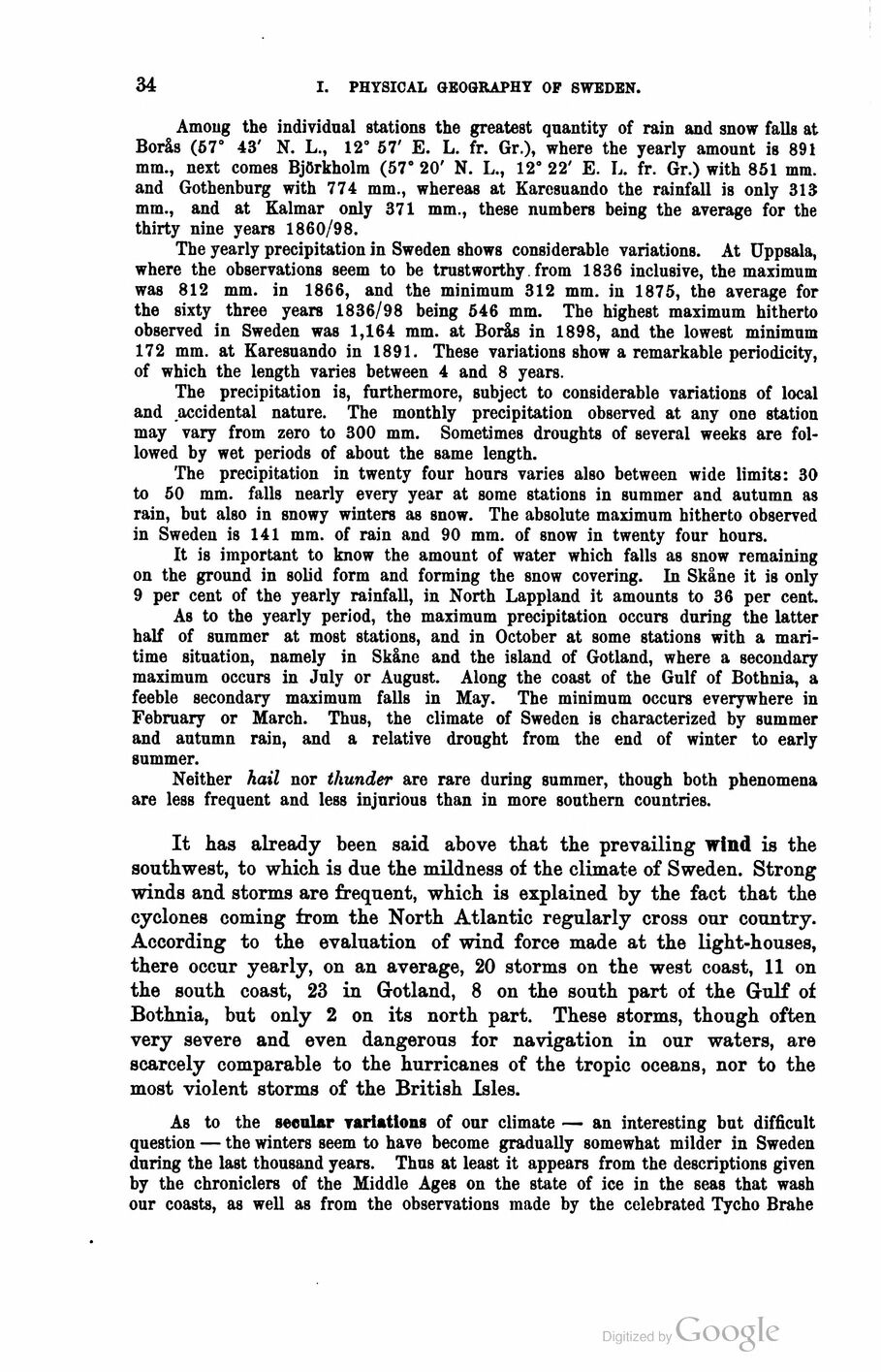
Full resolution (JPEG) - On this page / på denna sida - First part - I. Physical Geography - 2. Climate. By N. Ekholm, Ph. D., Central Meteorological Office, Stockholm

<< prev. page << föreg. sida << >> nästa sida >> next page >>
Below is the raw OCR text
from the above scanned image.
Do you see an error? Proofread the page now!
Här nedan syns maskintolkade texten från faksimilbilden ovan.
Ser du något fel? Korrekturläs sidan nu!
This page has never been proofread. / Denna sida har aldrig korrekturlästs.
34
I. PHYSICAL GEOGRAPHY OF SWEDEN.
Among the individual stations the greatest quantity of rain and snow falls at
Borås (57° 43’ N. L., 12° 57’ E. L. fr. Gr.), where the yearly amount is 891
mm., next comes Björkholm (57° 20’ N. L., 12° 22’ E. L. fr. Gr.) with 851 mm.
and Gothenburg with 774 mm., whereas at Karesuando the rainfall is only 313
mm., and at Kalmar only 371 mm., these numbers being the average for the
thirty nine years 1860/98.
The yearly precipitation in Sweden shows considerable variations. At Uppsala,
where the observations seem to be trustworthy. from 1836 inclusive, the maximum
was 812 mm. in 1866, and the minimum 312 mm. in 1875, the average for
the sixty three years 1836/98 being 546 mm. The highest maximum hitherto
observed in Sweden was 1,164 mm. at Borås in 1898, and the lowest minimum
172 mm. at Karesuando in 1891. These variations show a remarkable periodicity,
of which the length varies between 4 and 8 years.
The precipitation is, furthermore, subject to considerable variations of local
and accidental nature. The monthly precipitation observed at any one station
may vary from zero to 300 mm. Sometimes droughts of several weeks are
followed by wet periods of about the same length.
The precipitation in twenty four hours varies also between wide limits: 30
to 50 mm. falls nearly every year at some stations in summer and autumn as
rain, but also in snowy winters as snow. The absolute maximum hitherto observed
in Sweden is 141 mm. of rain and 90 mm. of snow in twenty four hours.
It is important to know the amount of water which falls as snow remaining
on the ground in solid form and forming the snow covering. In Skåne it is only
9 per cent of the yearly rainfall, in North Lappland it amounts to 36 per cent
As to the yearly period, the maximum precipitation occurs during the latter
half of summer at most stations, and in October at some stations with a
maritime situation, namely in Skåne and the island of Gotland, where a secondary
maximum occurs in July or August. Along the coast of the Gulf of Bothnia, a
feeble secondary maximum falls in May. The minimum occurs everywhere in
February or March. Thus, the climate of Sweden is characterized by summer
and autumn rain, and a relative drought from the end of winter to early
summer.
Neither hail nor thunder are rare during summer, though both phenomena
are less frequent and less injurious than in more southern countries.
It has already been said above that the prevailing wind is the
southwest, to which is due the mildness of the climate of Sweden. Strong
winds and storms are frequent, which is explained by the fact that the
cyclones coming from the North Atlantic regularly cross our country.
According to the evaluation of wind force made at the light-houses,
there occur yearly, on an average, 20 storms on the west coast, 11 on
the south coast, 23 in Gotland, 8 on the south part of the Gulf of
Bothnia, but only 2 on its north part. These storms, though often
very severe and even dangerous for navigation in our waters, are
scarcely comparable to the hurricanes of the tropic oceans, nor to the
most violent storms of the British Isles.
As to the secular variations of our climate — an interesting but difficult
question — the winters seem to have become gradually somewhat milder in Sweden
during the last thousand years. Thus at least it appears from the descriptions given
by the chroniclers of the Middle Ages on the state of ice in the seas that wash
our coasts, as well as from the observations made by the celebrated Tycho Brahe
<< prev. page << föreg. sida << >> nästa sida >> next page >>